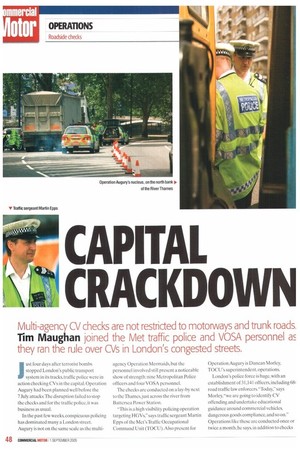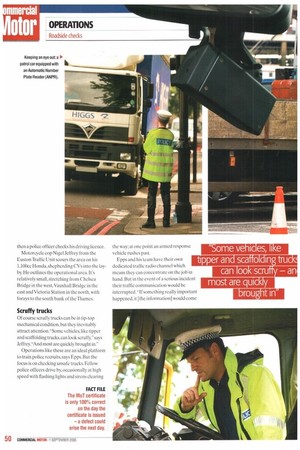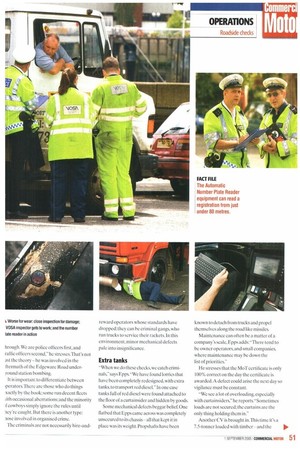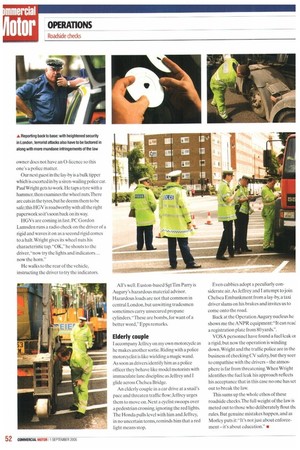I CAPITAL
Page 48

Page 49

Page 50

Page 51

Page 52

If you've noticed an error in this article please click here to report it so we can fix it.
CRACKDOWN
Multi-agency CV checks are not restricted to motorways and trunk roads. Tim Maughan joined the Met traffic police and VOSA personnel as
they ran the rule over CVs in London's congested streets.
Just four days after terrorist bombs stopped London's public transport system in its tracks, traffic police were in action checking CVs in the capital. Operation Augury had been planned well before the 7 July attacks.The disruption failed to stop the checks and for the traffic police, it was business as usual.
In the past few weeks, conspicuous policing has dominated many a London street. Augury is not on the same scale as the multi agency Operation Mermaids, but the personnel involved still present a noticeable show of strength:nine Metropolitan Police officers and four VOSA personnel.
The checks are conducted on a lay-by next to the Thames, just across the river from Battersea Power Station.
-This is a high visibility policing operation targeting HGVs," says traffic sergeant Martin Epps of the Met's Traffic Occupational Command Unit (TOCU). Also present for Operation Augury is Duncan Morley, TOCU's superintendent. operations.
London's police force is huge, with an establishment of 31,141 officers, including 68 road traffic law enforcers. "Today," says Morley,"we are going to identify CV offending and undertake educational guidance around commercial vehicles, dangerous goods compliance, and so on." Operations like these are conducted once or twice a month, he says, in addition to checks on individual trucks and vans on a daily basis.
Driving in London can be a brutal experience — the sheer number of cars, vans, taxis and trucks often leads to horrendous congestion. But motorcycles can generally find a way through the traffic, so Operation Augury includes two.
Checks like these, Morley explains, serve as a deterrent, reminding rogue operators of the potential consequences. Drivers' hours and the condition of vehicles have always come under scrutiny, but nowadays the terrorist threat also has to be borne in mind when conducting checks.
Carefully choreographed
The operation is carefully choreographed.A motorcycle officer stops CVs and marshals them back to the check area.The other bike officer stands at the side of the road directing vehicles into the lay-by. About 100m up the road, two officers sit in a traffic patrol car equipped with an Automatic Number Plate Reader (ANPR).A camera automatically snaps the registration plates of oncoming vehicles; anything amiss and an alarm is triggered.
A truck is directed into the lay-by."What is your mileage, driver?" asks VOSA vehicle examiner Paul Wright.The driver responds, then a police officer checks his driving licence.
Motorcycle cop Nigel Jeffrey from the Euston Traffic Unit scours the area on his 1,100cc Honda, shepherding CVs into the layby. He outlines the operational area. It's relatively small, stretching from Chelsea Bridge in the west,Vauxhall Bridge in the east and Victoria Station in the north, with forays to the south bank of the Thames.
Scruffy trucks
Of course scruffy trucks can be in lip-top mechanical condition, but they inevitably attract attention."Sorne vehicles, like tipper and scaffolding trucks, can look scruffy," says Jeffrey. 'And most are quickly brought in."
Operations like these are an ideal platform to train police recruits, says Epps. But the focus is on checking unsafe trucks. Fellow police officers drive by, occasionally at high speed with flashing lights and sirens clearing the way; at one point an armed response vehicle rushes past.
Epps and his Learn have their own dedicated traffic radio channel which means they can concentrate on the job in hand. But in the event of a serious incident their traffic communication would be interrupted. "If something really important happened, it [the information] would come hrough.We are police officers first, and raflic officers second," he stresses.That's not ast the theory — he was involved in the ft ermath of the Edgeware Road underround station bombing.
It is important to differentiate between iperators.There are those who do things xactly by the book; some run decent fleets iith occasional aberrations; and the minority ,f cowboys simply ignore the rules until !iey're caught. But there is another type: :lose involved in organised crime. The criminals are not necessarily hire-and reward operators whose standards have dropped; they can be criminal gangs, who run trucks to service their rackets. In this environment, minor mechanical defects pale into insignificance.
Extra tanks
When we do these checks, we catch criminals," says Epps. We have found lorries that have been completely redesigned, with extra tanks, to transport red diesel." In one case tanks full of red diesel were found attached to the floor of a curtainsider and hidden by goods.
Some mechanical defects beggar belief. One flatbed that Epps came across was completely unsecured to its chassis—all that kept it in place was its weight. Propshafts have been known to detach from trucks and propel themselves along the road like missiles.
Maintenance can often he a matter of a company's scale, Epps adds: "There tend to be owner operators, and small companies, where maintenance may be down the list of priorities."
He stresses that the MoT certificate is only 100% correct on the day the certificate is awarded. A defect could arise the next day so vigilance must be constant.
-We see a lot of overloading, especially with curtainsiders," he reports. "Sometimes loads are not secured; the curtains are the only thing holding them in.
Another CV is brought in.This time it's a 7.5-tonner loaded with timber — and the owner does not have an 0-licence so this one's a police matter.
Our next guest in the lay-by is a bulk tipper which is escorted in by a siren-wailing police car. Paul Wright gets to work. He taps a tyre with a hammer, then examines the wheel nuts.There are cuts in the tyres, but he deems them to be safe; this HGV is roadworthy with all the right paperwork so it's soon back on its way.
HGVs are coming in fast. PC Gordon Lumsden runs a radio check on the driver of a rigid and waves it on as a second rigid comes to a halt. Wright gives its wheel nuts his characteristic tap. "OK," he shouts to the driver,"now try the lights and indicators... now the horn."
He walks to the rear of the vehicle, instructing the driver to try the indicators. All's well. Euston-based Sgt Tim Parry is Augury's hazardous material advisor. Hazardous loads are not that common in central London, but unwitting tradesmen sometimes carry unsecured propane cylinders. "These are bombs, for want of a better word," Epps remarks.
Elderly couple I accompany Jeffrey on my own motorcycle as he makes another sortie. Riding with a police motorcyclist is like wielding a magic wand. As soon as drivers identify him as a police officer they behave like model motorists with immaculate lane discipline as Jeffrey and I glide across Chelsea Bridge.
An elderly couple in a car drive at a snail's pace and threaten traffic flow; Jeffrey urges them to move on. Next a cyclist swoops over a pedestrian crossing, ignoring the red lights. The Honda pulls level with him and Jeffrey, in no uncertain terms, reminds him that a red light means stop. Even cabbies adopt a peculiarly considerate air.As Jeffrey and! attempt to join Chelsea Embankment from a lay-by, a taxi driver slams on his brakes and invites us to come onto the road.
Back at the Operation Augury nucleus he shows me the ANPR equipment: "It can read a registration plate from 80 yards.".
VOSA personnel have found a fuel leak or a rigid, but now the operation is winding down. Wright and the traffic police are in the business of checking CV safety, but they seer to empathise with the drivers — the atmosphere is far from threatening. When Wright identifies the fuel leak his approach reflects his acceptance that in this case no one has set out to break the law.
This sums up the whole ethos of these roadside checks.The full weight of the law is meted out to those who deliberately flout th( rules. But genuine mistakes happen, and as Morley puts it: "It's not just about enforcement — it's about education."




































































































































































































